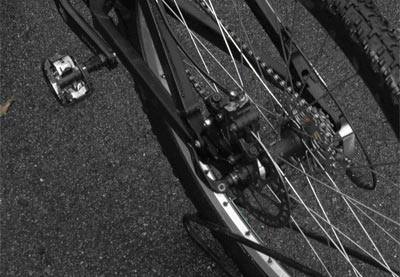
Most four bar linkage full suspension bike have their main pivot just above the bottom bracket. Since pedaling feedback come from a variation in the chain lengh, this pivot should ideally be placed
on the BB instead of near it. This would equal a constant chain lengh no matter where the bike is in its travel, without the use of a crazy pivot system (like the Giant Maestro). Probably that the design constrains were to have bearing small enough to get around the bb while being still strong. Several manufacturer have produced such a design. Jamis with the carbon Diablo, Rotec, Dean and then this custom frame builder. The bike shown here succeded well on this task. The bearings are german needle bearing, both small in diameter and strong (the rear-end looks a lot like a Dean). The design are is a faux-bar, with the secondary pivot on the rearstay instead of on the chainstay. This a maybe more prone to brake-lock than the patented Specialized horst-link, but it ensure that the chain is always at the same lengh. This would allow this bike to run a single-speed cog, are more logically for a 2000$ frame, a Rohloff hub. The downfall of this design is that a little bit a chaingrow might be good for traction, but again, at the price of pedaling feedback. This bike is made by a small american frame builder out of steel. I lost the manufacturer website, but I will had it to this post soon.


 Most four bar linkage full suspension bike have their main pivot just above the bottom bracket. Since pedaling feedback come from a variation in the chain lengh, this pivot should ideally be placed on the BB instead of near it. This would equal a constant chain lengh no matter where the bike is in its travel, without the use of a crazy pivot system (like the Giant Maestro). Probably that the design constrains were to have bearing small enough to get around the bb while being still strong. Several manufacturer have produced such a design. Jamis with the carbon Diablo, Rotec, Dean and then this custom frame builder. The bike shown here succeded well on this task. The bearings are german needle bearing, both small in diameter and strong (the rear-end looks a lot like a Dean). The design are is a faux-bar, with the secondary pivot on the rearstay instead of on the chainstay. This a maybe more prone to brake-lock than the patented Specialized horst-link, but it ensure that the chain is always at the same lengh. This would allow this bike to run a single-speed cog, are more logically for a 2000$ frame, a Rohloff hub. The downfall of this design is that a little bit a chaingrow might be good for traction, but again, at the price of pedaling feedback. This bike is made by a small american frame builder out of steel. I lost the manufacturer website, but I will had it to this post soon.
Most four bar linkage full suspension bike have their main pivot just above the bottom bracket. Since pedaling feedback come from a variation in the chain lengh, this pivot should ideally be placed on the BB instead of near it. This would equal a constant chain lengh no matter where the bike is in its travel, without the use of a crazy pivot system (like the Giant Maestro). Probably that the design constrains were to have bearing small enough to get around the bb while being still strong. Several manufacturer have produced such a design. Jamis with the carbon Diablo, Rotec, Dean and then this custom frame builder. The bike shown here succeded well on this task. The bearings are german needle bearing, both small in diameter and strong (the rear-end looks a lot like a Dean). The design are is a faux-bar, with the secondary pivot on the rearstay instead of on the chainstay. This a maybe more prone to brake-lock than the patented Specialized horst-link, but it ensure that the chain is always at the same lengh. This would allow this bike to run a single-speed cog, are more logically for a 2000$ frame, a Rohloff hub. The downfall of this design is that a little bit a chaingrow might be good for traction, but again, at the price of pedaling feedback. This bike is made by a small american frame builder out of steel. I lost the manufacturer website, but I will had it to this post soon.







